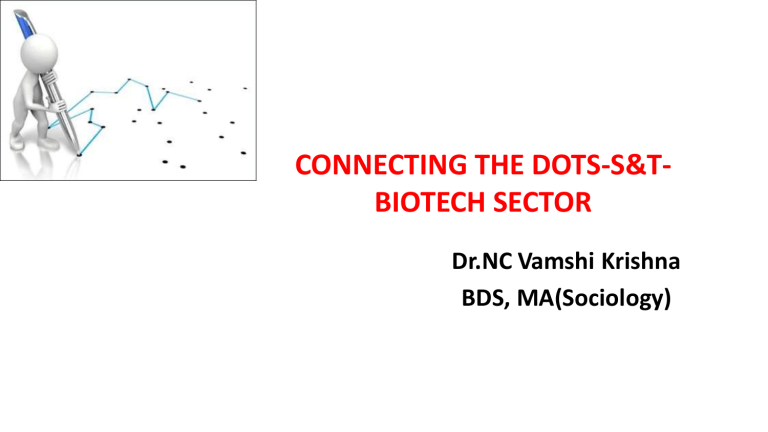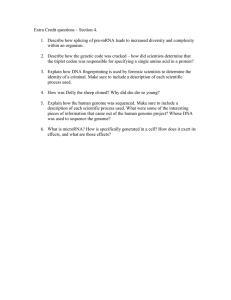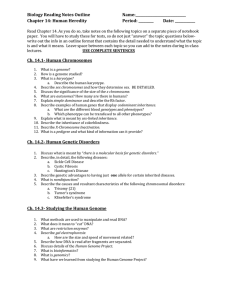
CONNECTING THE DOTS-S&TBIOTECH SECTOR Dr.NC Vamshi Krishna BDS, MA(Sociology) ABOUT ME • • • • • • • Works for Govt. of India (Ministry of S&T) in Bengaluru, India Training civil services aspirants from past four years at a prominent civil services institute and website in Bengaluru. Attended Three UPSC CSE Interviews- 2014, 2015, 2016 One of the toppers in Sociology- 2014, 2015 CSE. Also qualified SSC , ACIO and SBI PO Mains. Plus Educator since June 2019 Mentees include Current IAS ( AIR-470), OPSC 2nd Rank 2018, CAPF probationers etc. BREAKING THE MISCONCEPTIONS • • • • 100% Scoring but neglected due to lack of attention Fear and misconception. Lack of focus on basics. Usually straight forward questions INTRODUCTION • Biotechnology is defined as the industrial application of living organisms and their biological processes such as biochemistry, microbiology, and genetic engineering, to make the best use of the microorganisms for the benefit of mankind. TYPES AND APPLICATIONS HUMAN GENOME PROJECT GENOME INDIA PROJECT • • • The Department of Biotechnology under the Ministry of Science and Technology has cleared the Genome India Project. It is a gene-mapping project involving 20 leading institutions including the Indian Institute of Science (IISc) in Bengaluru and a few Indian Institute of Technology (IITs). The Centre for Brain Research, which is an autonomous institute in the IISc, Bengaluru, will serve as the nodal point of the project • • • The diverse genetic pool of India will be mapped and it will help in making personalized medicine. Today, the goal of personalized medicine is to utilize information about a person's genes, including his or her nucleotide sequence, to make drugs better and safer. It will be a hard task considering the population diversity and the disease burden of complex disorders like diabetes, mental health, etc but once the genetic basis is ready it will be possible and easy to take action before the onset of a disease. RECOMBINANT DNA TECHNOLOGY CRISPR-IN THE NEWS • • • Clustered Regularly Interspaced Short Palindromic Repeats (CRISPR) is a gene editing technology, which replicates natural defence mechanism in bacteria to fight virus attacks, using a special protein called Cas9. CRISPR-Cas9 technology behaves like a cutand-paste mechanism on DNA strands that contain genetic information. The specific location of the genetic codes that need to be changed, or edited, is identified on the DNA strand, and then, using the Cas9 protein, which acts like a pair of scissors, that location is cut off from the strand. • • • • MECHANISM A piece of RNA called guide RNA (gRNA). This consists of a small piece of pre-designed RNA sequence This part binds to DNA and the predesigned sequence ‘guides’ Cas9 to the right part of the genome. This makes sure that the Cas9 enzyme cuts at the right point in the genome. The guide RNA has RNA bases that are complementary to those of the target DNA sequence in the genome. This means that the guide RNA will only bind to the target sequence and no other regions of the genome. APPLICATIONS • • • • Genome editing is of great interest in the prevention and treatment of human diseases. Currently, most research on genome editing is done to understand diseases using cells and animal models. The technology is being explored in research on a wide variety of diseases, including single-gene disorders such as cystic fibrosis, haemophilia, and sickle cell disease. It also holds promise for the treatment and prevention of more complex diseases, such as cancer, heart disease, mental illness, and human immunodeficiency virus (HIV) infection. CRISPR-Cas9 has a lot of potential as a tool for treating a range of medical conditions that have a genetic component, including cancer, hepatitis B or even high cholesterol. ETHICAL CONCERNS • • • • Making genetic modifications to human embryos and reproductive cells such as sperm and eggs is known as germline editing. Since any changes made in germline cells using CRISPR-Cas9 technology will be passed on from generation to generation. It has raised a number of ethical concerns. Another ethical challenge germline cell and embryo genome editing brings up includes whether it would be permissible to use this technology to enhance normal human traits (such as height or intelligence). There are growing concerns of trying to produce “designer” babies or altered human beings. GENOME VANDALISM • There is also the phenomenon of "off-target effects," where DNA is cut at sites other than the intended target. This can lead to the introduction of unintended mutations. Furthermore, even when the system cuts on target, there is a chance of not getting a precise edit. This is called as "genome vandalism." https://unacademy.com/@krisco1811 MY CODE : KRISCO1811




